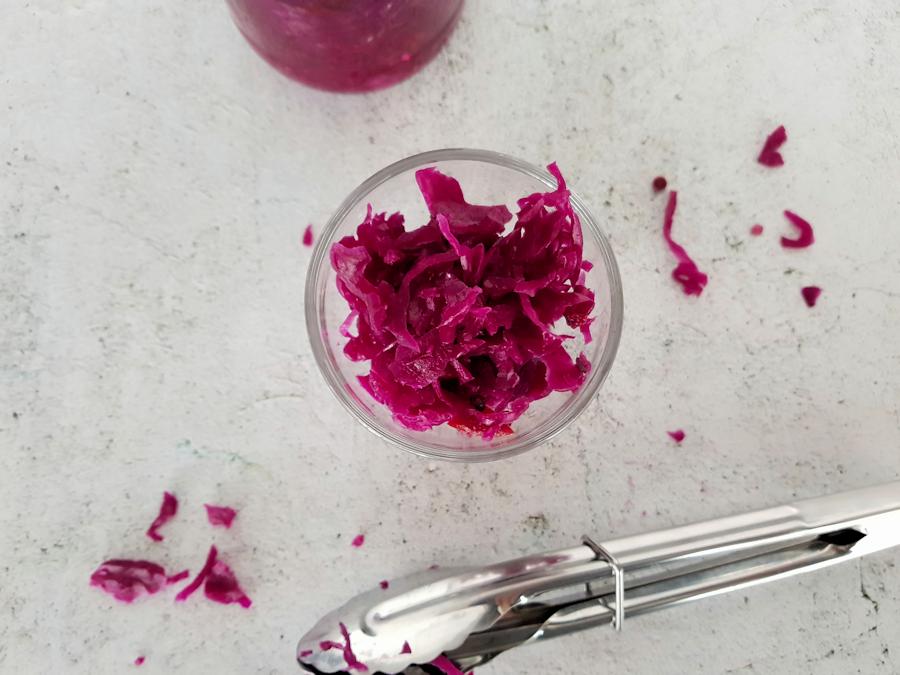Red sauerkraut; fermented red cabbage with a bit of heat and a bit of bite. Who needs kimchi?

Why we waste so much food?
FOGO – Fear Of Going Off – is one of the major reasons why food waste in the western world reaches monumentally frightening levels.
Past the sell-by, gone use-by, is it still good? better safe than sorry, terror of food poisoning; all of that causes tonnes of perfectly edible foodstuffs to end in the landfill. It’s a sin; it’s a crime.
Overshopping aside, FOGO makes people respect the sell-by dates on the labels like they’d been created by an omniscient being. We’re lost when there’s no date, like in vegetables and fruit.
It’s as if we had no longer any sense of smell and sight, or taste at a push. If it looks, smells and tastes good – it’s good to eat.
Dairy product labels are especially infuriating: I promise you I use my cream and milk still about a week after the label tells me to. When dairy is off, you really can’t mistake it.
Off? It's just aged
We forget that going off under other monikers is actually a desirable method of preparing or preserving food.
Aged beef? Why, it’s just nicely rotten.
Air dried Parma ham that costs fifty quid per kilo is the meat that very slowly decomposes is special conditions. Raw pork is tough as anything – Parma ham melts on the tongue.
It figures – rotting softens the meat.
Fermenting is extending the use-by date
We can also make vegetables, fruit and legumes go off into something tasty by fermenting.
It is thankfully gaining popularity because it brings not only a variety in diet but also friendly bacteria to your gut.
First sourdough, later kombucha and finally poor old cabbage is getting some traction – not least thanks to the Korean cuisine and its ubiquitous kimchi.
Sauerkraut kimchi style
My version is a kind of fusion: kimchi-style seasoning with chillies and ginger, but I ferment red cabbage, the North European stalwart.
I believe that Korean cuisine uses predominantly Napa cabbage also known as Chinese leaf. Red cabbage is firmer which gives the final product interesting texture.
And anyway, who says red cabbage can only be cooked for hours with plums and red wine to be served with goose at Christmas?
How to set up a fermentation station
One head of red cabbage makes about two 2-pound jars of ready condiment. So if you want to immerse yourself and your family slowly, use just half a head for one jar. And it is HOT so not eaten in huge quantities.
The cabbage needs to be shredded quite finely so employ your best knife skills or a food processor.
The first stage is salting: sprinkling isn’t enough, you need to massage the salt into the cabbage with your hands thoroughly. At this stage the cabbage is in the bowl which gets covered with a cloth and sits overnight in room temperature.
All the fun happens the following day. After adding all the aromatics to the cabbage and preparing a clean jar, the mix needs to be packed tightly into the jar and pressed down to extract as much air from between cabbage layers as possible.
In the past, in Northern Europe they used to pack the cabbage down in barrels by climbing into them and stomping with bare feet! Similar, but slightly less romantic procedure as its winemaking equivalent.
The pickling liquid collected in the bowl needs to be poured over so the cabbage is immersed. If you place a small tumbler or a pebble at the mouth of the jar, it will help keep it under.
It should sit in a cool and dark place, covered only with a muslin cloth, for at least a week. After the first 24 hours check if rogue strands have not floated to the top and if so, push them back in.
You can do the first tasting after a week, or keep it up to 3, it depends on personal taste. I like it crunchy and still a little fresh tasting, but if you prefer to squint and pucker up, keep it fermenting longer.
A word of warning: the cabbage does smell a bit while it ferments, being covered only with a cloth. So if you can house it in a cupboard in a cooler corner of the kitchen, your family won’t suspect you of any horrific wrongdoings.
More fermenting recipes
White cabbage is the classic sauerkraut material and you can happily shred just one head to make a jar or two.
Basic kimchi made with Napa cabbage, salted and mixed with spice paste made from Korean chili powder, fish and soy sauce. Left to ferment for up to a week.
Less fermentation, more instant gratification: quick refrigerator pickles made with cucumbers, asparagus and carrot slices. These quick pickles are ready in 3 hours and keep more nutritious elements than ordinary pickles.
More cabbage recipes
Brilliantly refreshing after an eternity of mixed leaves, spring cabbage salad is perfect with fish, great with chicken and an absolute must for a barbecue.
Festive red cabbage stir fried with apples, raisins and spices, super quick to cook. Red cabbage can be cooked super quick and easy, not only for Christmas.
Vietnamese cabbage and prawn salad with nuoc mam dressing, layered on baked brown rice. The best salad bowls are a/ Asian and b/ contain cabbage.